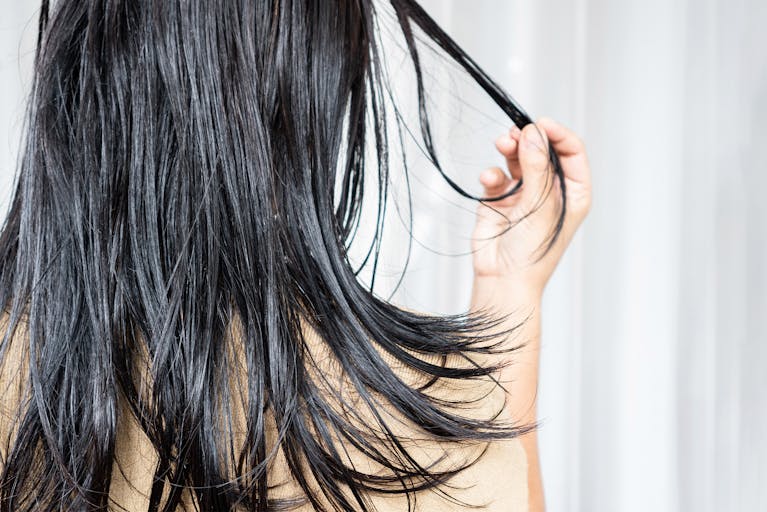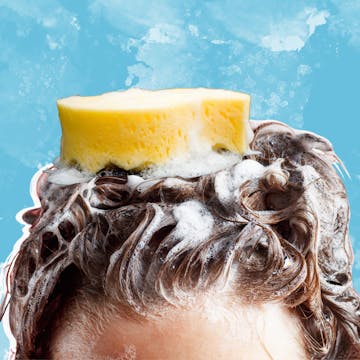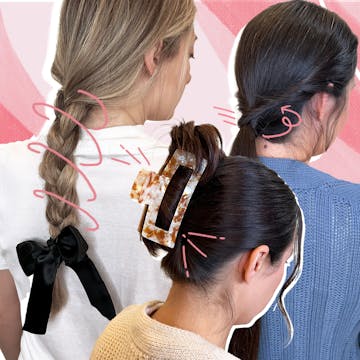Why Is My Hair So Oily? And How to Fix It.
Discover the root causes of oily hair and simple ways to prevent it.
No matter your hair type, hair care routine, or wash frequency, nearly every single one of us has dealt with oily roots at some point in our lives. Why? Because our hair naturally produces oil. So if you struggle with chronically oily hair, just know that you are not alone.
Regularly greasy strands can occur for a myriad of reasons that are actually quite common—but it’s essential to pinpoint the cause of excess oil so that you can solve your oily root situation. Keep reading to understand what causes greasy hair and get expert advice on how to handle it.
Why Hair Gets Oily
All of us have natural hair oils that can sometimes go into overdrive for one reason or another. We produce these scalp oils (or sebum) as a natural way to hydrate the scalp and protect the hair—so not all oil is bad oil. That said, if you find yourself constantly dealing with more grease than you’d like, there are several common reasons why this could be going on.
Genetics & Hair Type
Genetics and hair type can play a role in how much oil you naturally produce. For example, curly, coarse hair has a reputation for being dry, while straight, fine hair is often considered to be more grease-prone. In other words, it might be just the way your hair naturally functions—and that’s okay.
Overwashing or Underwashing
If you wash your hair every day and still deal with oily roots, overwashing may be the culprit. Shampooing is an essential part of your routine to wash away dirt, grime, and product buildup, but when you wash your hair, you also strip it of some of its natural oils. If you wash your hair too often, you can trigger an overproduction of those natural oils, resulting in excess sebum production.
However, you have to strike the right balance. Underwashing your hair can lead to built-up product, dirt, and sweat, which also causes roots to feel greasy. Experiment with your wash routine until you find what works best for you.
Using Heavy Products or Too Much Product
Most generic hair products are designed to cater to the average person, allowing them to have broad appeal on the shelves. But as we all know, every person and their hair type is unique. Generic hair products can be too heavy for someone who deals with greasy strands, so look for products that specifically cater to your hair type or try custom hair care.
Using too much product can also result in hair feeling too greasy. Only use as much as you need and give hair a thorough wash before applying more product. More product does not always mean better results; it just means you have more stuff on your hair.
Hormonal Changes
Hormones play a big role in almost every aspect of our lives. If you’re going through a big change like pregnancy or menopause, you may notice a shift in how much sebum your hair produces. The good news is that these changes can be temporary, but you’ll still need to adjust your routine to reduce greasy roots.
Lifestyle Choices
When dealing with oily strands, your lifestyle may make an impact. If you touch your hair a lot throughout the day, the oil and grime on your hands can transfer to your hair. The same can be said for dirty linens and pillowcases. You also want to clean your hairbrush or comb so that you’re not dragging old dirt and product through clean hair. Nutrition can also have an impact on overactive sebaceous glands, so be sure to enjoy a nutrient-rich, hair-healthy diet.
5 Expert Tips for Dealing with Oily Hair
Find the Right Wash Frequency for You
Everyone’s scalp is different, so there’s no one-size-fits-all answer to how often you should wash your hair. Some people may need to cleanse daily, while others do best with every three days. The key is experimenting until you find a rhythm that leaves your scalp balanced and your hair refreshed. Pay attention to how your roots look and feel, then adjust accordingly. Once you land on the sweet spot, you’ll notice your scalp stays cleaner for longer.
Use a Gentle Clarifying Shampoo
Clarifying shampoos are designed to cut through stubborn buildup, excess oil, and leftover product, but they can also be drying if overused. Choose a gentle clarifying formula that’s safe for occasional use, so you can refresh your strands without stripping them.
This type of shampoo works especially well if you use a lot of styling products or live in an area with hard water. Incorporating it into your routine once a week (or even once a month) can help reset your scalp. Just be sure to follow up with a lightweight conditioner to keep your ends hydrated.
Apply Conditioner Only to Mid-lengths & Ends
Conditioner is essential for keeping strands soft and hydrated, but applying it to your roots can weigh hair down and make it look greasy. Instead, focus on the mid-lengths and ends, where hair is drier and more prone to breakage. Using too much product on the scalp can block follicles and trap oils, which only intensifies the problem. A lightweight formula is usually enough to smooth your hair without overloading it.
Avoid Heavy Styling Products
Products that are too rich, like thick creams, oils, or hair masks, can quickly overwhelm your strands if you’re prone to oiliness. Instead, opt for lightweight sprays, mousses, or serums that won’t sit heavily on the scalp.
Using fewer products overall can also help prevent buildup that clogs follicles and attracts dirt. If you love styling products, try applying them only from mid-length to ends, avoiding your roots completely. This approach helps you achieve the look you want while keeping greasy roots at bay.
Use Dry Shampoo for Quick Touch-Ups
Dry shampoo is a lifesaver for refreshing hair between washes. It works by absorbing excess oil at the roots, instantly giving hair a cleaner, more voluminous look. Spray it in sections at the crown and part, let it sit for a minute, then massage it in for best results.
It’s perfect for extending the life of your blowout or getting through a busy week without daily washing. Just remember that dry shampoo is a temporary fix, not a substitute for regular cleansing.
Oily hair is a common struggle, but with the right routine and products, it’s completely manageable. By understanding what triggers excess oil and making a few simple adjustments, you can keep your roots fresh and your strands looking their best. It’s all about balance and finding what works for your unique hair type. With a little trial and error, you’ll be well on your way to healthy-looking hair.





